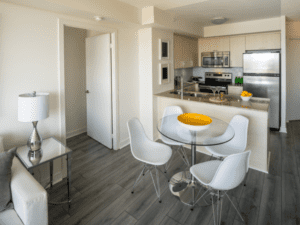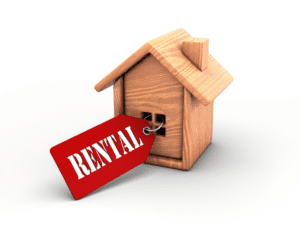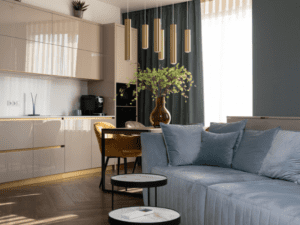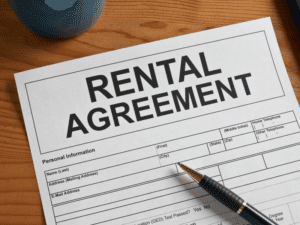Jan 11 2024 35 mins 1
Hello and welcome to The Property Management Show podcast, your go-to destination for exploring the dynamic world of property management, entrepreneurship, and marketing. Brought to you by Fourandhalf Marketing Agency, a leader in the industry since 2012.
Fourandhalf helps residential property managers get more owner leads and improve their online presence through website design and development, SEO, online reputation management, video and blog content, social media, and targeted advertising.
Recap of Part 1: Establishing the Foundation of Mid-Term Rentals
In Part 1 – Maximizing Profits with Mid-Term Rentals: Property Management Blue Ocean Strategy, our guest speakers Jessica Schirmeister and Jason Zimmerman from Trend Property Management in Texas discussed the growing trend of mid-term rentals. These types of rentals, also known as furnished rentals, have become increasingly popular in recent years.
That episode highlighted the unique niche that mid-term rentals occupy, situated between short-term and long-term rentals. Key focus areas included the demand for these types of properties, their profitability potential, and the evolving rental market trends influenced by remote work and lifestyle changes. The episode provided foundational insights into the benefits, challenges, and operational dynamics of managing mid-term rentals.
In this episode (Part 2), we’ll delve deeper into the operational challenges and strategies for managing mid-term rentals. We’ll discuss finances and the subtle art of balancing tenant rights with property management objectives.
 Evaluating Investment in Mid-Term Rentals
Evaluating Investment in Mid-Term Rentals
Part 2 starts with a discussion about the financial feasibility of investing in mid-term rentals and ensuring a reasonable return on investment (ROI). Jessica shared an example of how a month-long tenant could provide up to four times the revenue compared to a traditional annual lease. However, she also emphasized the necessity of factoring in additional costs such as furnishing, utilities, and cleaning fees when evaluating the profitability of mid-term rentals.
Jason stressed that property managers should be strategic in their investment, considering the demand and market conditions. It’s important to understand potential risks and always have a backup plan in case the rental doesn’t succeed as expected.
Financial Considerations and Return on Investment
Investing in mid-term rentals is an intriguing proposition, blending the stability of long-term rentals with the higher earning potential typical of short-term stays. For property managers and investors, understanding the financial landscape is key. This involves assessing the initial investment costs against the potential returns. Mid-term rentals often demand a higher rental rate, reflecting their furnished status and flexibility. This can be an attractive proposition for tenants looking to avoid long-term commitments.
Cost-Benefit Analysis: Investing in Furnishings and Amenities
While discussing the financial aspects of investing in mid-term rentals, Jessica and Jason also shed light on the pros and cons of furnishing a property.
Furnishings can attract more tenants:
- Mid-term renters are often looking for fully furnished properties to make their stay comfortable and convenient.
- Furnishings can add value to the rental experience and justify higher rent prices.
- In a competitive market, furnished properties may stand out and attract more tenants.
Furnishings can also come with additional costs:
- Investing in quality furniture can be expensive upfront.
- Managing and maintaining furnishings requires time and effort.
- There is always the risk of damage or wear-and-tear from tenants, which may require replacements or repairs.
To get an initial understanding of whether furnishing a rental makes sense, evaluate if the property in question can generate an additional $4,000 or more each month. Jason says that after evaluating over 50 deals, this seems to be a key threshold for justifying the investment in furnished rentals.
Here are some other key financial aspects that were discussed during the interview:
1.) Fixed Costs vs. Property Value:
It was noted that the fixed costs associated with a property do not necessarily decrease with a less expensive property. These fixed costs can erode the benefits of furnishing a property if the additional revenue generated doesn’t sufficiently cover these expenses.
2.) Revenue Threshold for Profitability:
Looking at the big picture, furnishing a property starts to make even more financial sense when it can generate significant additional revenue – in the range of $50,000 to $70,000 a year. This extra gross revenue is needed to cover all additional expenses such as utilities and other costs associated with furnished rentals.
3.) Increasing Rental Value Without Increasing Taxes or Insurance:
One of the strategic financial advantages discussed was the ability to significantly increase the rental value of a property through furnishing without correspondingly increasing the property tax base or insurance expenses. Most property improvements and upgrades can translate to higher insurance or property taxes, and this puts furnishing in a unique spot.
This aspect is particularly important as it implies that furnishing a property can lead to higher income without proportionally higher ongoing costs.
 What are the Goals of the Property Owner?
What are the Goals of the Property Owner?
In addition to financial considerations, you should also think about the long-term goals of the property owners. Key points from this part of the conversation include:
1.) Owner’s Net Profit Goals:
The decision to convert a property into a furnished rental is often influenced by the owner’s specific financial objectives. For some, an increase in net profit of around $5,000 a year is a benchmark that makes the investment worthwhile. However, this threshold can vary among different property owners, depending on their individual financial goals and circumstances.
2.) Long-Term Strategic Planning:
Another critical factor in this decision-making process is the owner’s long-term strategic plan for the property. If an owner intends to keep the property in excellent condition for an extended period, such as for inheritance purposes, they might be more inclined to furnish it. The rationale is that a furnished property can be maintained at a much higher level, ensuring its longevity and preservation over the years.
These considerations highlight the importance of aligning the decision to furnish a rental property with the owner’s long-term financial and strategic objectives. It’s not just about the immediate returns but also about how this decision fits into the broader picture of their property management and investment goals.
Having explored the financial considerations and owner’s objectives in detail, it becomes clear that the decision to venture into mid-term rentals is multifaceted. Now let’s dive into the nitty gritty of what types of furniture will and will not work for a furnished rental property.
The Art of Furnishing Rental Properties
 When it comes to furnishing rental properties, it’s a delicate balancing act between expense and attractiveness. Quality furnishings and amenities can significantly increase a property’s appeal and rental value. The key is in finding the sweet spot – investing enough to make the property desirable and competitive, while ensuring that these costs are recouped through higher rental income and occupancy rates. This strategic approach to investing can lead to enhanced long-term profitability.
When it comes to furnishing rental properties, it’s a delicate balancing act between expense and attractiveness. Quality furnishings and amenities can significantly increase a property’s appeal and rental value. The key is in finding the sweet spot – investing enough to make the property desirable and competitive, while ensuring that these costs are recouped through higher rental income and occupancy rates. This strategic approach to investing can lead to enhanced long-term profitability.
Can I Use Old Furniture in the Rental Property?
We know the thought of using old furniture may have crossed your mind, or at least the property owner’s mind. We don’t blame you. Jessica shared that it’s common for property owners to consider using their existing furniture to save costs. However, several important points were raised about the potential drawbacks of this approach:
1.) Quality and Aesthetics:
It was emphasized that for rentals charging higher rates (e.g., $4,000 and above), tenants expect a certain level of quality and aesthetics. Using old furniture with visible wear, like stains or damage, could lead to negative reviews and dissatisfaction among tenants.
2.) Why Does the Owner Want to Part With It?
The conversation also underscored the importance of effectively communicating with property owners about the standards expected in furnished rentals. It’s crucial to explain why old furniture might not be suitable and how it could impact the tenant’s experience and the property’s appeal.
Our guests suggest asking a very simple question “Why don’t you want to use this in your own home?” This straightforward query can help property owners understand why it may not be suitable for a rental.
3.) Cost of Replacement or Repairs:
It’s also essential to consider the potential costs of maintaining and repairing old furniture if it breaks down during a tenant’s stay. These expenses could add up over time, making it more cost-effective to invest in newer, higher-quality furnishings.
The speakers discussed the possibility of using some of the owner’s existing furnishings, but not all. The selection process involves assessing each item to ensure it meets the required standard for the rental market.
 The Best Furniture for Rental Properties
The Best Furniture for Rental Properties
Part of the property manager’s job is guiding owners through the process of updating their furnishings, including providing them with estimates for new furniture. This helps owners understand the financial implications and the value added by investing in quality furnishings.
Here are several tips and tricks to help identify the best furniture options for mid-term rental:
- Durability is Key: Mid-term rentals are subject to more wear and tear than traditional long-term rentals, making durability a top priority when selecting furnishings. Investing in quality pieces that can withstand heavy use can save money in the long run, as they will require fewer repairs and replacements.
- Make Practical Choices: When selecting items, practicality is a key consideration. For instance, choosing white towels and linens that can be bleached between guests was cited as a beneficial practice. This approach adds value for guests while simplifying maintenance and upkeep.
- Neutral Designs with a Touch of Personality: When it comes to furniture design, opting for neutral colors and styles can appeal to a broader range of tenants. However, incorporating small touches of personality, such as through throw pillows or artwork, can add character and make the space feel more inviting.
- Multi-Functional Furniture: With space being a premium in many rental properties, it’s essential to maximize functionality. Multi-functional furniture, such as a pull-out sofa bed or storage ottoman, can provide additional sleeping or storage options without taking up extra space.
- Consider the Location: It’s also crucial to consider the location of the rental property when selecting furniture. For example, a beachfront property may benefit from more casual and comfortable furnishings, while a city apartment may require a sleeker and more modern design.
In conclusion, furnishing rental properties requires a combination of strategic planning, understanding market demands, and investing in quality pieces that will withstand heavy use. By aligning the owner’s objectives with these factors, mid-term rentals can provide a profitable and attractive option in the evolving rental market. So, property managers need to stay updated with industry trends and continually adapt their strategies to cater to emerging demands.
Treating Furnished Rentals as a Business
Mid-term rentals require a business mindset. This means understanding the financial aspects of investing in furnishings and ensuring that these costs are recouped through higher rental rates and occupancy rates.
Additionally, treating furnished rentals as a business also involves focusing on guest satisfaction and continuously making improvements to the property to meet market demands.
Our guest, Jason, provided the perfect analogy to help drive home the point. He likened starting a furnished rental business to opening a restaurant, emphasizing the need for good-quality furnishings, much like a restaurant needs good tables and chairs. This analogy highlighted the importance of viewing furnished rentals not just as properties but as full-fledged businesses that require investment in quality assets.
Depreciation Is On Your Side
One significant advantage of furnished rentals is the potential for tax benefits. Property managers and owners can take advantage of depreciation deductions on furniture, effectively reducing taxes owed on rental income.
Jason suggested that property owners consult with their CPAs to understand how investing in furniture (e.g., a $45,000 investment) can be depreciated. Unlike real estate property, which is depreciated over several decades, furniture typically has more favorable depreciation schedules, allowing for faster recovery of investment through tax benefits.
Buying Furniture – A Great Investment Opportunity
Investing in furniture for a rental property can be a smart way to add value to the property, especially if the owner has funds available for investment but is uncertain about the best way to utilize them. The depreciation aspect makes this investment more financially attractive and can be a strategic way to enhance the property’s value. Additionally, furnishing a rental property can also increase its overall appeal and attract more desirable tenants.
Viewing mid-term rentals as a business opportunity that requires strategic planning, understanding market demands, and investing in quality furnishings can lead to success.
Now that we’ve talked about the business side of things, let’s talk about the other piece of the puzzle: your renters.
 Resident Rights vs. Property Management Objectives
Resident Rights vs. Property Management Objectives
In the realm of property management, especially in the context of mid-term rentals, a crucial yet often delicate aspect is striking the right balance between tenant rights and property management objectives.
The core of this discussion revolved around the principle of ‘quiet enjoyment,’ a tenant’s legal right to use and enjoy a rented property without undue interference. This principle is a cornerstone in real estate and applies universally, regardless of whether the arrangement is short-term or mid-term, and whether the occupants are referred to as guests or tenants.
Understanding ‘Quiet Enjoyment’
Quiet enjoyment refers to the tenant’s right to use the property as intended without unnecessary restrictions or intrusions from the landlord. It’s a foundational concept that underscores the tenant’s autonomy over the rented space during their tenancy.
Marie and Brittany shared a recent Airbnb experience where they were not allowed to wear shoes inside the house and they were also not allowed to adjust the thermostat freely. These seemingly minor restrictions significantly impacted their overall experience and their satisfaction with the property.
The Landlord-Tenant Relationship in Property Management
A critical insight from the podcast was the emphasis on recognizing the inherent landlord-tenant relationship in property management. This relationship holds, irrespective of the rental’s duration or how the occupants are labeled. Every tenant, whether in a short-term Airbnb setup or a mid-term rental, is entitled to specific rights, which include the use of the property as designed.
Challenges for New Property Managers
The discussion highlighted a common challenge for those new to property management or hosting. Many enter the field without a formal real estate background, which can lead to a lack of awareness about fundamental tenant rights. This knowledge gap can inadvertently lead to infringements on tenant rights, such as unnecessary meddling in the tenant’s use of the property.
Striking the Right Balance
For property managers, the key takeaway is the need to balance effectively managing their properties while respecting the tenants’ rights. This balance is essential not only for maintaining a positive tenant relationship but also for adhering to legal standards in property management. Recognizing and respecting tenant rights, such as quiet enjoyment, plays a crucial role in successful property management and ensures a harmonious landlord-tenant dynamic.
Property managers must navigate the fine line between upholding tenant rights and ensuring their own objectives are met. This may involve setting clear expectations from the beginning, regular communication with tenants, and addressing any issues promptly and professionally.
Resident Privacy in Rentals
Privacy is a fundamental aspect of the rental experience, especially in mid-term rentals that serve as a temporary home for renters. It forms a crucial part of the tenant’s right to quiet enjoyment, and violations can significantly impact their satisfaction and overall rental experience.
As a property manager, you should ensure that the tenant’s privacy is respected at all times. This includes avoiding unannounced visits or inspections, and not restricting tenants’ use of the property unless necessary for maintenance or other justified reasons. Respecting privacy not only helps build trust and a positive relationship between the tenant and the landlord, but it also contributes to attracting and retaining quality tenants. A rental arrangement that respects privacy can set your property apart in the competitive rental market and help enhance your overall business success.
 Video Surveillance in Rental Properties: Yay or Nay?
Video Surveillance in Rental Properties: Yay or Nay?
An interesting anecdote was shared by Jason Zimmerman about his personal experience with video surveillance in a rental property. This segment of the conversation sheds light on how surveillance can impact the guest experience and, in turn, the property’s reviews and reputation.
Jason Zimmerman’s Creepy Anecdote
Jason recounted an incident that occurred while he was staying at an Airbnb for a funeral. He had family members come over to the rental property so they could travel to the funeral together. However, the rental’s host sent him a notice, having observed six people entering the property through the doorbell camera. This intrusion prompted Jason to unplug the modem, essentially saying, “leave me alone.” His reaction stemmed from a feeling of being monitored or stalked, which is a common discomfort among guests in such scenarios.
The Unintended Consequences of Surveillance
This story highlights a crucial aspect of guest relations in the rental business. Surveillance, intended for security purposes, can often cross the line into privacy invasion, leading to guest discomfort. Such experiences can be particularly jarring for guests who are there for sensitive occasions, like funerals.
Jason shared that there is data showing that a staggering 98% of Airbnb guests dislike any form of video surveillance in rental properties. This strong aversion to surveillance cameras, including popular devices like Ring cameras, was emphasized as a major concern for guests.
Balancing Security with Guest Comfort
The conversation points to the need for property managers to carefully consider their approach to security measures like video surveillance. While ensuring property safety is important, it’s equally crucial to maintain a level of privacy and trust that guests expect. Infringing on this trust can lead to negative experiences, as demonstrated by Jason’s reaction to being monitored.
Implications for Reviews and Property Reputation
Instances like these can significantly affect a property’s reviews and overall reputation. Guests who feel their privacy is invaded are more likely to leave negative feedback, which can deter future potential guests. The story shared by Jason underlines the importance of respecting guest privacy and carefully evaluating the use of surveillance equipment in rental properties.
Prioritizing Tenant Privacy
The key takeaway from this discussion is the importance of prioritizing tenant privacy in furnished rental properties. While security is a valid concern, it must be balanced with the need to provide a welcoming and private space for tenants. Intrusive surveillance measures can undermine this balance, potentially harming the relationship between the landlord and tenant, and ultimately affecting the property’s appeal and reputation.
 Reviews Can Make or Break Success
Reviews Can Make or Break Success
In the rental industry, particularly in furnished and mid-term rentals, guest reviews play a critical role. Positive reviews can significantly boost a property’s reputation and desirability, leading to higher occupancy rates and rental income.
Attention to detail and responsiveness to tenant needs are paramount. Property managers are often tasked with addressing maintenance requests promptly and efficiently. This proactive approach not only ensures tenant satisfaction but also helps in maintaining the property in top condition, thereby enhancing its long-term value.
Strategies for Positive Reviews
To encourage positive reviews from guests, it is essential to:
1.) Provide High-Quality Furnishings:
Furnishings should not only be functional but also aesthetically pleasing. This enhances the overall appeal of the property and contributes to a positive guest experience.
2.) Prioritize Comfort and Convenience:
Comfortable furniture and well-equipped properties are more likely to receive positive feedback from guests.
3.) Respond Promptly to Requests:
Addressing maintenance issues and guest queries promptly shows attentiveness and care, leading to better reviews.
4.) Ensure Transparency and Communication:
Clear communication about property rules and amenities helps in setting the right expectations, thereby reducing misunderstandings and negative reviews.
5.) Solicit Feedback Proactively:
Encouraging guests to share their experiences and suggestions can provide valuable insights for improvements and also show guests that their opinions are valued.
 Legal and Regulatory Landscape for Mid-Term or Furnished Rentals
Legal and Regulatory Landscape for Mid-Term or Furnished Rentals
As with any business, it is essential to understand the legal and regulatory landscape that governs mid-term rentals. This understanding can help property managers ensure compliance and avoid potential legal issues.
In the podcast, when asked about the potential for increased regulation in mid-term rentals similar to what has been seen in short-term rentals, Jessica Schirmeister and Jason Zimmerman provided insights into the current state and future possibilities.
City and HOA Regulations
Jessica Schirmeister, one of the speakers, highlighted that regulations over rentals could come from two main sources: the city and homeowners’ associations (HOAs). She emphasized the importance of being aware of the specific rules and regulations set by these entities. In client meetings, they often check the city’s regulations and the HOA rules to ensure compliance.
She urges other property managers and investors to conduct diligent research and compliance checks with both the city and the relevant HOA as a starting point.
The Significance of the 30-Night Threshold
A crucial point noted in the discussion was the prevalence of a 30-night minimum stay requirement, often seen in both city rules and HOA regulations. This requirement seems to be a common benchmark distinguishing short-term from mid-term rentals, with mid-term rentals typically starting at stays longer than 30 nights.
Property managers and landlords must be aware of this threshold to ensure compliance with regulations.
The Future of Mid-Term Rentals: Trends and Opportunities
Jason Zimmerman provided insights into the anticipated trends in the mid-term rental market. His perspective was rooted in the current usage patterns and market developments.
Stability in Tenant Activities
One of the key points Jason raised was the similarity in tenant activities between mid-term rentals and traditional 12-month leases. Whether it’s for six months or a year, the impact on neighborhoods and the way tenants use the properties are quite alike. This observation suggests that mid-term rentals are unlikely to cause significant disruptions or attract undue regulatory attention, maintaining a level of stability akin to long-term rentals.
Regulatory Outlook
Given these similar usage patterns, Jason expressed his view that mid-term rentals might not face the same level of regulatory challenges as short-term rentals. Short-term rentals are often scrutinized for their potential neighborhood impact, but the consistency in tenant behavior in mid-term rentals could spare them from such intense regulatory focus.
A Rising Trend in Furnished Homes
Looking towards the future, Jason highlighted a growing trend: the increasing demand for furnished homes for various lease durations. This trend, particularly evident in college markets and upscale areas over the past decade, points to a robust and expanding market for mid-term rentals. The demand for furnished homes, suitable for a range of leasing terms, is on the rise, signaling a significant growth opportunity in this sector.
Conclusion
As we wrap up this episode on the vibrant world of mid-term rentals, it’s clear there’s a lot to get excited about. From savvy investment strategies to the fine art of balancing tenant needs with business goals, mid-term rentals offer a world of opportunity for the savvy property manager.
We’ve navigated through the nuts and bolts of furnishing, tenant privacy, and the all-important reviews that can make or break your property’s rep. Plus, we’ve tackled the ever-changing legal landscape to keep you in the know.
Thanks for diving into this rental adventure with us!
If you haven’t subscribed to our newsletter yet, head on over to https://fourandhalf.com/subscribe/ to make sure you don’t miss future episodes of The Property Management Show Podcast.
P.S. If you are looking to get more owner leads, improve your online visibility, and grow your property management business, fill out the form below to see how Fourandhalf Marketing Agency can help you reach those goals.
The post Mid-Term Rentals Part 2: Strategies for Success in Managing Furnished Properties appeared first on Fourandhalf Marketing Agency for Property Managers.